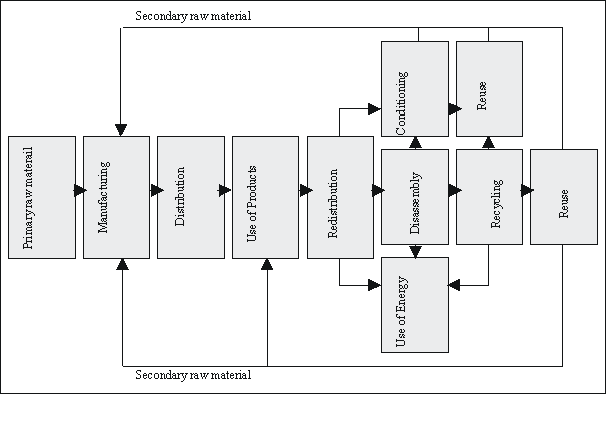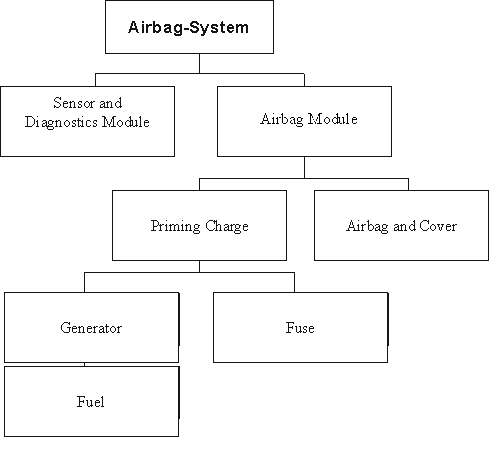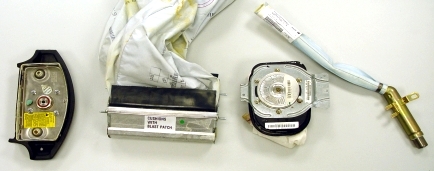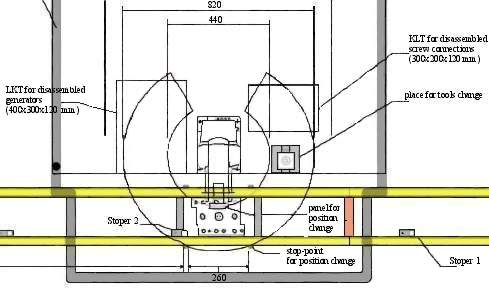|
|
|
SOLUTIONS FOR THE DISASSEMLEY OF UNDEPLOYED AIRBAGS Heiko Vesper ABSTRACT Since the resources of mankind are limited, the reusage of materials from obsolete products is necessary and gets more important day to day. INTRODUCTION AND CHARACTERIZATION OF THE NEED FOR LOGISTICS SOLUTIONS In 1996, a law was created to define the circular flow of potentially recyclable resources in Germany (KrW-/AbfG). It contains the promotion of the circular flow of potentially recyclable resources to save natural resources as well as the maintenance of environmentally safe waste disposal. Given this new law, the definition of the circular flow of potentially recyclable resources follows chart 1. In the automotive industry the national law for used cars regulates this flow. Basis for this regulation was the guideline for used cars of the European parliament and the European Council (2000/53/EG). Starting from 1st of January 2006 it adjusts the utilization and recycling quota of material and energy recycling.
This quota will increase in 2015 up to 95% in total. The utilization of material by shred and fractionation is a commonly used method. However it is not possible to use this method to recycle active airbags. Already used airbags can be shred but it is hard to find companies to do so. The reason for this lies in the assumption that a used airbag is contaminated und not suitable for recycling. Shredding active airbags results in an uncontrolled distribution of explosives in the shred facility. This may lead to a dangerous situation in which the explosives are capable of an explosion of unknown impact.
Nevertheless it is necessary to follow the regulations for recycling. To achieve this, it is essential to undergo the process of dismantlement of "armed" airbags. Additionally, the guidelines for handling of explosives are accomplished by the use of automatic disassembly processes. CONSTRUCTION AND DISTRIBUTION OF AIRBAGS An airbag is a basic equipment for almost each car, which has been manufactured for the last 10 years. Airbags for driver and co-driver as well as sidebags or windowbags are build-in to prevent the inmates from damages. The picture 2 shows the construction of an airbag in principle. To achieve a logistics solution the focus lies only on the airbag module and its components as relevant parts. The generator and the fuse are the main parts of the airbag. They are responsible for the expansion of the airbag in case of crash. They have to be extracted and destroyed. It is important to distinguish between the pyrotechnical generators with an exact amount of fuel and hybrid generators that produces the necessary quantity of gas in a very short time. Another element, the cover, is made of plastics, produced by injection moulding. The airbag is made of different polyamide fabrics. Although, the components of an airbag are the same, they differ in shape and construction as presented in the picture.
This variety depends on the purposes of the airbags. These purposes are quite important to determine the dimensions of the solution. A problem is the connect determination of the actual lifetime of an airbag and the strains of these airbags. Consequently it is required to use estimations and forecasts that reflect a number of 6 million airbags in the year 2006. The cause for this high number is the increased need for security in cars. Rules for the installation of airbags in buses and trucks are already in use. LOGISTICS REQUIREMENTS FOR THE DISASSEMBLY OF ACTIVE AIRBAGS The process characteristics of the disassembly General parts are:
The present industrial disassemblement is more or less characterized by manual labour especially in the field of airbag disassemblement. The requirements for automatization have their roots in two reasons:
Legal framework The legal framework results from the fact, that active airbags are explosives and are subjects of the law for explosives (SprengG), the guideline for warehousing of explosives, the regulations for hazardous goods and the regulations for hazardous goods on streets (GGVS/ADR). These rules are valid not only for the transport of the airbags but also for the time of warehousing them. DEFINITION OF THE DIFFERENT TECHNOLOGIES FOR THE DISASSEMBLEMENT Due to the high numbers of manually dismantled airbags it was possible to obtain crucial results, which are important to determine the following processes. It was feasible to define for the mainly used airbags only two different technologies (A and B). The determination is characterized by the removal of the generator. While type A contains a generator, which is removable from the side facing the driver, type B contains a generator, which is turned away from the driver in the process of disassemblement. As an extra step, the time for the manual labour was calculated. With these data it has become possible to specify an aimed-at time for the eventual automated process. CHARACTERIZATION OF ELEMENTS FOR THE SOLUTION ID-systems, which are associated with the process The identification system, which is associated with the process, must use a technique, which is already in use. Currently every airbag has to be identified during the manufacturing process. To accomplish this, it is necessary to use a barcode system, which is applied by the manufacturer himself on the chassis of the airbag. It is important to have access via a manual barcode scanner. The advantage of this already used system lies in the reduction of input errors. In case a barcode is not able to be read by a scanner, the employee will input the data manually. Starting from the point of storage, the airbag is available for the whole system. This includes the automatic placing of the storage area and the allocation of specific programs for the disassemblement. Development on a modular instep- and transport system According to the demands of the processes of disassemblement, the innovative development must contain the following steps:
The transport system is based on an existing system made of conveyors and transport boxes. Control of the system network The control in the system network is using a main computer. This computer has access to all interconnected parts and contains the main control center. With its help, all relevant commands for the disassemblement, controlling, monitoring and guidance for the subsystems are maintained. The main computer includes a central database and controls all data of the whole system including the flow of data. To assure a flawless process a secondary computer is used as "hot" redundancy. This way it makes it easy to maintain a continuous flow of data and an interruption-free process. The main computer controls two different areas; first the control of the storage process and second the control of the actual process of disassemblement. The control of storage processes includes a subsystem for identification, storage in and out. The transport, the robotic systems and additional identification are part of the second subsystem. A control system for emergencies is also implanted. This program stops all relevant processes of the disassemblement and the employee can interact without any danger if necessary. OVERALL SOLUTION Given the manual disassemblement and therefore the determination of the applied processes it was important to agree on the steps to implement all the process parts. To find a scientific and "optimal" solution, the morphologic scheme was applied. This scheme displays on one hand all possible characteristics of a potential solution and on the other hand all included processes. By connecting these characteristics it was possible to create a variety of different results. All results were evaluated via a value benefit analysis. This kind of analysis consists of 4 evaluation groups and their specific criteria. The group of economical criteria includes for example costs of investment, costs for maintenance, costs for implementing the solution and costs of the development. In the field of general criteria, it was considered to evaluate the necessary qualifications of potential employees, the lifetime of the components and the dimensions of the facility. The area of process specifications was determined by retrofitting, efficiency per shift, industrial safety / the risk of injuries and the ease of operation of the instep system. The magnitude of realization, market chances and the implementation of the business model or the adjustment for other potential uses illustrate the fourth group (perspectives of the different versions). Two versions emerged as favorable:
The main criterion that differs between these versions is the number of used robots. In version A, the transport system has the shape of the number eight and circulates around the robots. That leaves the possibility to work in different sections of the conveyor with the same tool. This version is the most efficient version but it is more expensive. Not only the investment of an additional robot and a more sophisticated conveyor is to be considered but also the higher costs of development and a more complex control system. All these considerations are the reasons to choose the version B. As to be seen in the picture, two focuses were made in the whole system of the disassembly facility: for ones the transport system and the other is bulletproof cell. Inside the cell the robot is operating according to the process steps. The different elements and the generator are put after the disassemblement in special boxes. The position for the connection elements is realized through deposited coordinates in the data pool or can be "trained" to the robot via the function "teach-in" which memorizes the coordinates and reproduces the data later on. The robot is located in a bulletproof and transparent cell. This cell makes it possible to monitor the whole process and to detect any dangers as soon as possible. Due to safety reason, the airbags are channeled in visual range of the cell.
The transport system (bottom part of the picture, in front of the cell) is responsible for the supply in and out of the cell. The injection area in the initial part of the transport system identifies the airbag and the instep tool is installed on the robot. Thanks to that, a slipping of the airbag is prevented. Additionally the instep tool is fixed to avoid any danger for the robot or its components. After the disassembly the transport system is moving to the start point. At the start point the instep system will be disengaged and the safe components will be extracted and deposited. Than it is possible to start the next cycle with the next airbag. The number of instep systems complies with the robots ability to disassemble. CONCLUSIONS The development of the airbag disassemblement cell has many advantages. The greatest benefits are the protection and safeness of the employees. The solution provides a high level of danger in the process of disassemblement. The introduced disassemblement cell stands for a maximum of flexibility. By using different technologies for the disassemblement process it was possible to gain a wide variety of possible uses. This disassembly cell is a real alternative in the light of the manual disassemblement. Only with this cell it is possible to achieve a safe process and to fulfill the needs of the circular flow of potentially recyclable resources. REFERENCES Airbag und Gurtstraffer, 2002, Vogel Buchverlag. Verwertung & Entsorgung Airbag- und Gurtstraffer, VDA, 2001. Gesetzestexte SprengG, SPrengV, SprengLR 240, GGVS. ROZWIĄZANIA DEMONTAŻU NIEZUŻYTYCH PODUSZEK POWIETRZNYCH
STRESZCZENIE Ponieważ surowce są dostępne ludzkości tylko w ograniczonych ilościach, odzyskiwanie surowców wtórnych z przestarzałych urządzeń jest metodą konieczną i nabierającą coraz większego znaczenia. ENTSORGUNGSLOGISTISCHE LÖSUNGEN FÜR DIE DEMONTAGE AKTIVER AIRBAGS
ZUSAMMENFASSUNG. Die Rohstoffe der Menschheit sind begrenzt. Daher wird der Einsatz von Sekundärrohstoffen immer wichtiger. Der deutsche Gesetzgeber hat dies erkannt und das Kreislaufwirtschaft und Abfallgesetz erlassen. Dies zwingt die Automobilhersteller zur Rücknahme und Verwertung von Altautos. Gängige Verwertungsmethode ist das Schreddern der Fahrzeuge. Besonders problematisch sind dabei die nicht ausgelösten Airbags, die ein beträchtliches Gefahrenpotential bergen. Die manuelle Demontage von Airbags ist sehr gefährlich, können diese doch beim Demontageprozess explodieren. Die einzige Lösung stellt die automatisierte Demontage dar. Dipl.-Wirtsch.-Ing. (FH) Heiko Vesper |
Copyright © 2005 LogForum, Wyższa Szkoła Logistyki, ul.E.Estkowskiego 6, tel. 061 852 95 55, 851 06 04, tel./fax. 061 851 06 03 |




